RWBI BIO0226: Evaluating Strategic Directions in Real World Business
VerifiedAdded on 2023/06/13
|14
|2782
|59
Report
AI Summary
This report examines the role of strategic direction in key business areas, including entrepreneurship, the SPICE framework, effective decision-making, and social innovation. It evaluates how strategic direction assists or hinders these areas and provides recommendations for enhancing operational activities. The analysis covers defining business ventures, setting strategic objectives, formulating strategies, and utilizing the SPICE framework for strategic development. It also discusses the importance of long-term decision-making and social innovation in aligning with societal needs. The report concludes with recommendations for the board of directors to incorporate strategic direction into various departments for improved organizational efficiency and performance.

Running head: REAL WORLD BUSINESS ISSUES
Real World Business Issues
Name of the Student:
Name of the University:
Real World Business Issues
Name of the Student:
Name of the University:
Paraphrase This Document
Need a fresh take? Get an instant paraphrase of this document with our AI Paraphraser
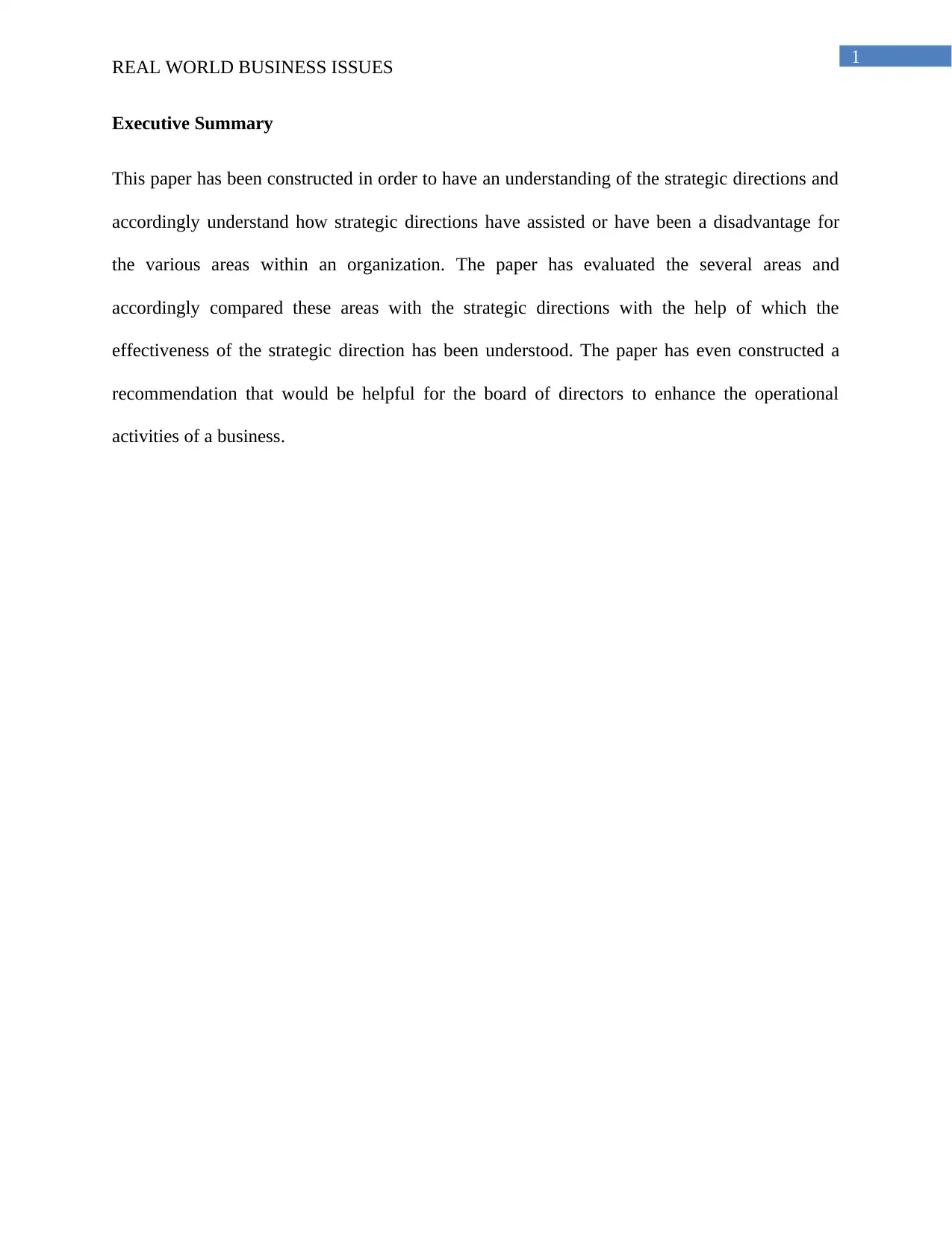
1
REAL WORLD BUSINESS ISSUES
Executive Summary
This paper has been constructed in order to have an understanding of the strategic directions and
accordingly understand how strategic directions have assisted or have been a disadvantage for
the various areas within an organization. The paper has evaluated the several areas and
accordingly compared these areas with the strategic directions with the help of which the
effectiveness of the strategic direction has been understood. The paper has even constructed a
recommendation that would be helpful for the board of directors to enhance the operational
activities of a business.
REAL WORLD BUSINESS ISSUES
Executive Summary
This paper has been constructed in order to have an understanding of the strategic directions and
accordingly understand how strategic directions have assisted or have been a disadvantage for
the various areas within an organization. The paper has evaluated the several areas and
accordingly compared these areas with the strategic directions with the help of which the
effectiveness of the strategic direction has been understood. The paper has even constructed a
recommendation that would be helpful for the board of directors to enhance the operational
activities of a business.
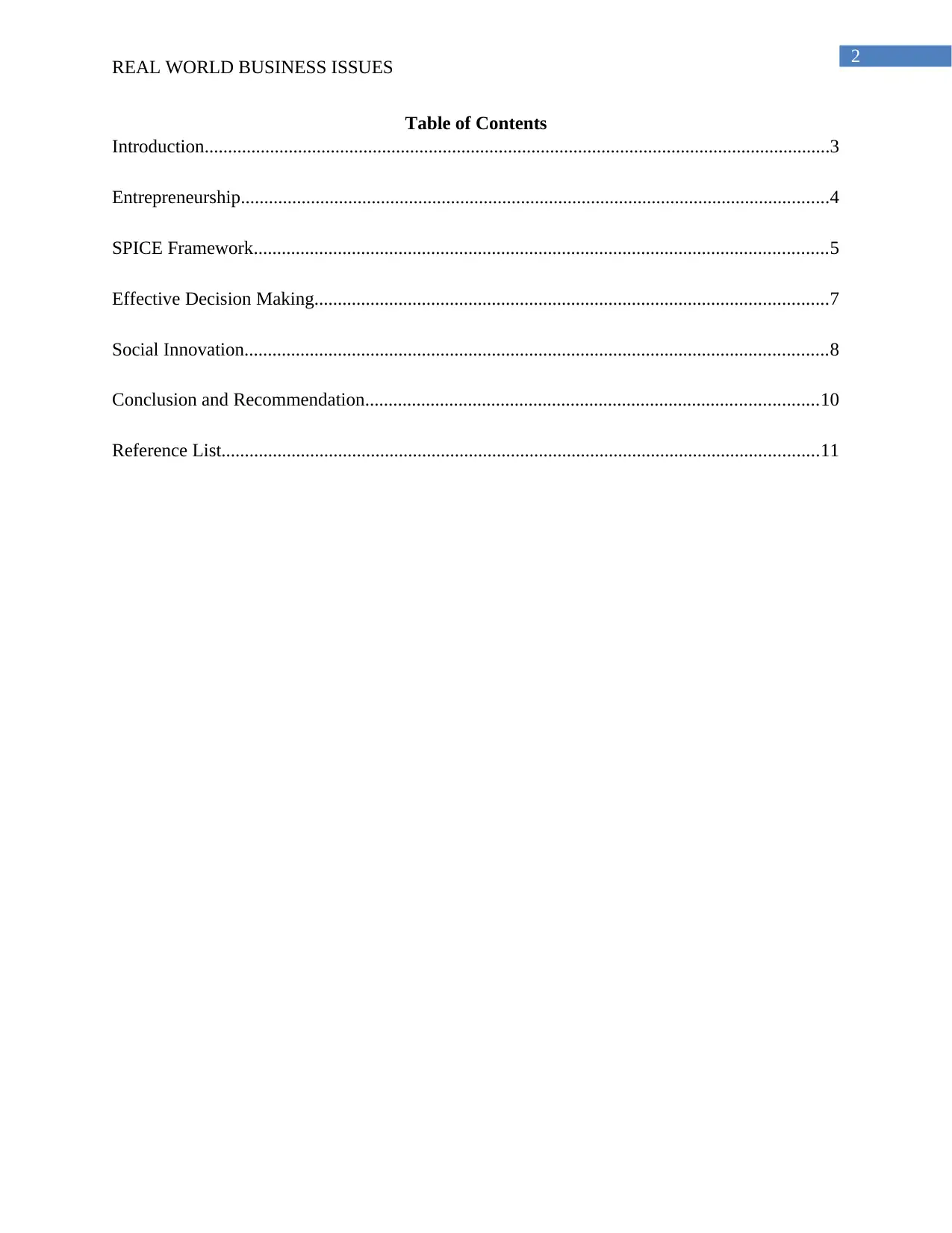
2
REAL WORLD BUSINESS ISSUES
Table of Contents
Introduction......................................................................................................................................3
Entrepreneurship..............................................................................................................................4
SPICE Framework...........................................................................................................................5
Effective Decision Making..............................................................................................................7
Social Innovation.............................................................................................................................8
Conclusion and Recommendation.................................................................................................10
Reference List................................................................................................................................11
REAL WORLD BUSINESS ISSUES
Table of Contents
Introduction......................................................................................................................................3
Entrepreneurship..............................................................................................................................4
SPICE Framework...........................................................................................................................5
Effective Decision Making..............................................................................................................7
Social Innovation.............................................................................................................................8
Conclusion and Recommendation.................................................................................................10
Reference List................................................................................................................................11
⊘ This is a preview!⊘
Do you want full access?
Subscribe today to unlock all pages.

Trusted by 1+ million students worldwide

3
REAL WORLD BUSINESS ISSUES
Introduction
In the modern world, strategic direction has an essential role to play in the process of
decision making, controlling and directing the operational activities of a business in an effective
manner. The process of strategic direction determines the extent of efficiency level of a company
and therefore, strategic direction is not only associated with the immediate operational
performance but is looked upon to be a long term objective (Werhahn et al., 2017). This paper
would therefore look to address the assistance of strategic direction in four key areas of a
business and thereby determine the effectiveness of strategic direction within an organization.
REAL WORLD BUSINESS ISSUES
Introduction
In the modern world, strategic direction has an essential role to play in the process of
decision making, controlling and directing the operational activities of a business in an effective
manner. The process of strategic direction determines the extent of efficiency level of a company
and therefore, strategic direction is not only associated with the immediate operational
performance but is looked upon to be a long term objective (Werhahn et al., 2017). This paper
would therefore look to address the assistance of strategic direction in four key areas of a
business and thereby determine the effectiveness of strategic direction within an organization.
Paraphrase This Document
Need a fresh take? Get an instant paraphrase of this document with our AI Paraphraser
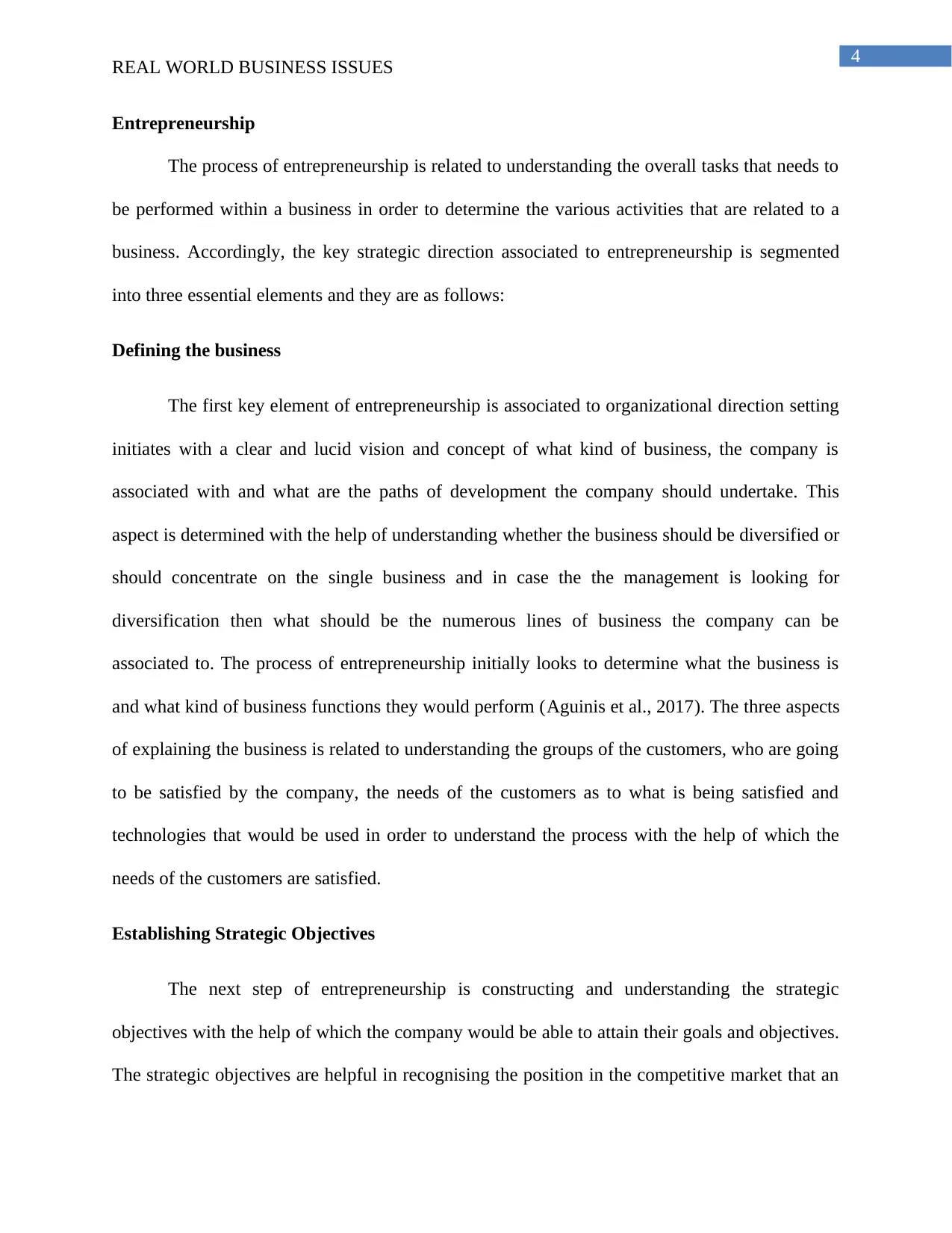
4
REAL WORLD BUSINESS ISSUES
Entrepreneurship
The process of entrepreneurship is related to understanding the overall tasks that needs to
be performed within a business in order to determine the various activities that are related to a
business. Accordingly, the key strategic direction associated to entrepreneurship is segmented
into three essential elements and they are as follows:
Defining the business
The first key element of entrepreneurship is associated to organizational direction setting
initiates with a clear and lucid vision and concept of what kind of business, the company is
associated with and what are the paths of development the company should undertake. This
aspect is determined with the help of understanding whether the business should be diversified or
should concentrate on the single business and in case the the management is looking for
diversification then what should be the numerous lines of business the company can be
associated to. The process of entrepreneurship initially looks to determine what the business is
and what kind of business functions they would perform (Aguinis et al., 2017). The three aspects
of explaining the business is related to understanding the groups of the customers, who are going
to be satisfied by the company, the needs of the customers as to what is being satisfied and
technologies that would be used in order to understand the process with the help of which the
needs of the customers are satisfied.
Establishing Strategic Objectives
The next step of entrepreneurship is constructing and understanding the strategic
objectives with the help of which the company would be able to attain their goals and objectives.
The strategic objectives are helpful in recognising the position in the competitive market that an
REAL WORLD BUSINESS ISSUES
Entrepreneurship
The process of entrepreneurship is related to understanding the overall tasks that needs to
be performed within a business in order to determine the various activities that are related to a
business. Accordingly, the key strategic direction associated to entrepreneurship is segmented
into three essential elements and they are as follows:
Defining the business
The first key element of entrepreneurship is associated to organizational direction setting
initiates with a clear and lucid vision and concept of what kind of business, the company is
associated with and what are the paths of development the company should undertake. This
aspect is determined with the help of understanding whether the business should be diversified or
should concentrate on the single business and in case the the management is looking for
diversification then what should be the numerous lines of business the company can be
associated to. The process of entrepreneurship initially looks to determine what the business is
and what kind of business functions they would perform (Aguinis et al., 2017). The three aspects
of explaining the business is related to understanding the groups of the customers, who are going
to be satisfied by the company, the needs of the customers as to what is being satisfied and
technologies that would be used in order to understand the process with the help of which the
needs of the customers are satisfied.
Establishing Strategic Objectives
The next step of entrepreneurship is constructing and understanding the strategic
objectives with the help of which the company would be able to attain their goals and objectives.
The strategic objectives are helpful in recognising the position in the competitive market that an
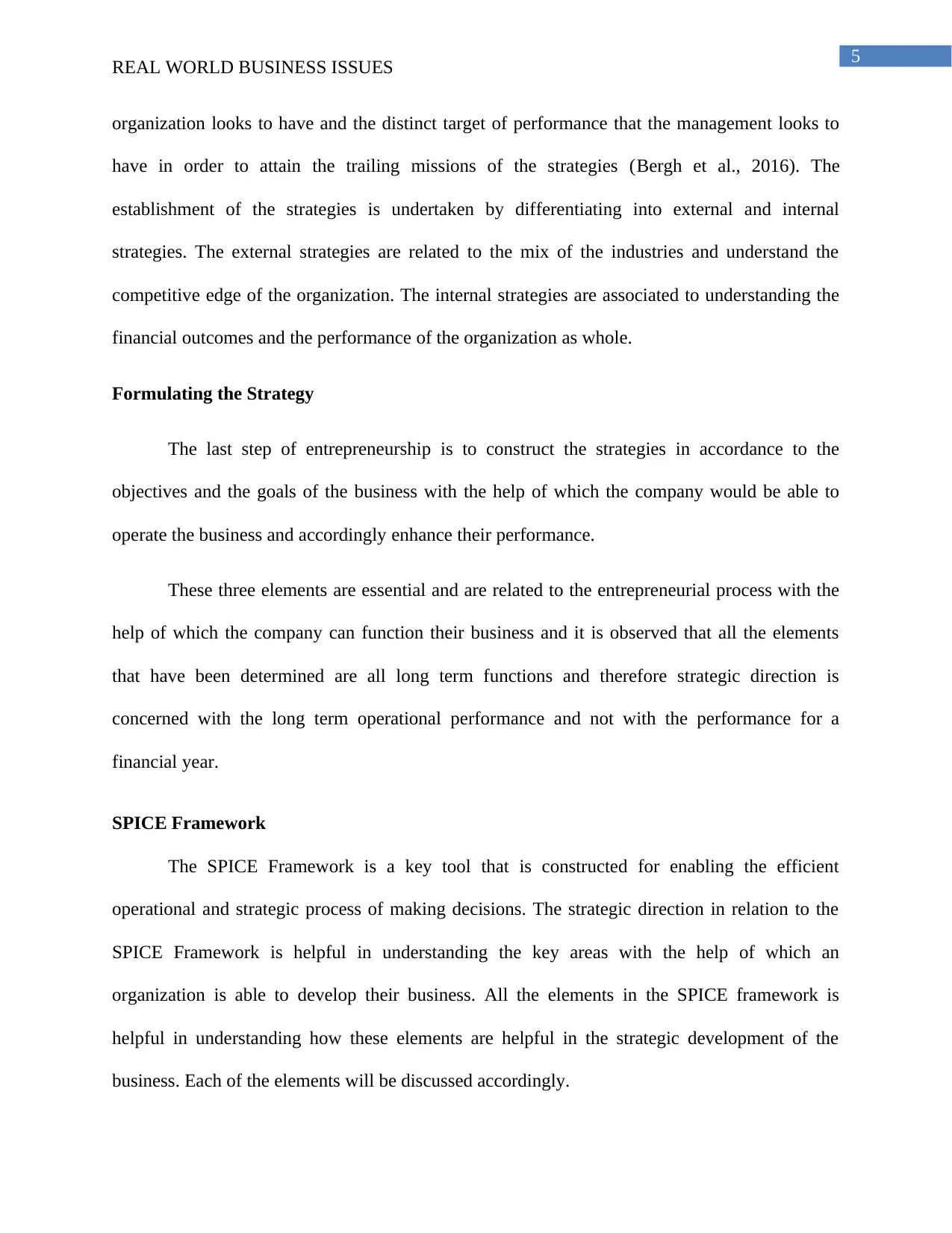
5
REAL WORLD BUSINESS ISSUES
organization looks to have and the distinct target of performance that the management looks to
have in order to attain the trailing missions of the strategies (Bergh et al., 2016). The
establishment of the strategies is undertaken by differentiating into external and internal
strategies. The external strategies are related to the mix of the industries and understand the
competitive edge of the organization. The internal strategies are associated to understanding the
financial outcomes and the performance of the organization as whole.
Formulating the Strategy
The last step of entrepreneurship is to construct the strategies in accordance to the
objectives and the goals of the business with the help of which the company would be able to
operate the business and accordingly enhance their performance.
These three elements are essential and are related to the entrepreneurial process with the
help of which the company can function their business and it is observed that all the elements
that have been determined are all long term functions and therefore strategic direction is
concerned with the long term operational performance and not with the performance for a
financial year.
SPICE Framework
The SPICE Framework is a key tool that is constructed for enabling the efficient
operational and strategic process of making decisions. The strategic direction in relation to the
SPICE Framework is helpful in understanding the key areas with the help of which an
organization is able to develop their business. All the elements in the SPICE framework is
helpful in understanding how these elements are helpful in the strategic development of the
business. Each of the elements will be discussed accordingly.
REAL WORLD BUSINESS ISSUES
organization looks to have and the distinct target of performance that the management looks to
have in order to attain the trailing missions of the strategies (Bergh et al., 2016). The
establishment of the strategies is undertaken by differentiating into external and internal
strategies. The external strategies are related to the mix of the industries and understand the
competitive edge of the organization. The internal strategies are associated to understanding the
financial outcomes and the performance of the organization as whole.
Formulating the Strategy
The last step of entrepreneurship is to construct the strategies in accordance to the
objectives and the goals of the business with the help of which the company would be able to
operate the business and accordingly enhance their performance.
These three elements are essential and are related to the entrepreneurial process with the
help of which the company can function their business and it is observed that all the elements
that have been determined are all long term functions and therefore strategic direction is
concerned with the long term operational performance and not with the performance for a
financial year.
SPICE Framework
The SPICE Framework is a key tool that is constructed for enabling the efficient
operational and strategic process of making decisions. The strategic direction in relation to the
SPICE Framework is helpful in understanding the key areas with the help of which an
organization is able to develop their business. All the elements in the SPICE framework is
helpful in understanding how these elements are helpful in the strategic development of the
business. Each of the elements will be discussed accordingly.
⊘ This is a preview!⊘
Do you want full access?
Subscribe today to unlock all pages.

Trusted by 1+ million students worldwide

6
REAL WORLD BUSINESS ISSUES
Strategy: The SPICE model assists the development of the flourishing and the existing
businesses with the help of changing the aspiration and the vision of the company into a plan that
is desirable with quantifiable impacts (Hartmann‐Boyce et al., 2017). The key are of the strategy
is helpful in determining the reasoned delivery and planning and the effect for the development.
Patterns: The SPICE Framework is a resource that is solution concentrated and accordingly
assists the managers, leaders and the entrepreneurs in order to recognise, construe and respond
accordingly and in an effectively to the present threats and the developing potentials (Ormazabal
et al., 2017). All these aspects are related to the long term operational function and therefore the
pattern that would be constructed needs to be maintained.
Individual: The SPICE Framework authorizes an organization and the individuals to develop
and flourish through constructing a cohesive and strong functioning relationships and acting to
the strengths of the organization. This section is related to connecting the performance of an
individual to the team and accordingly to the performance of the organization.
Context: The SPICE model enables the organizations to embellish with the help of modifying
the lucidness of the purpose, vision along with creating the self-belief within the companies
(Looy et al., 2014). This area discovers and attains the clarity about a company and their
developments that are on-going.
Emergence: This framework assists the enhancement of flourishing the business with the help of
creating the vision and the objective for the possibilities of the business. This zone concentrates
on creating insights for the development of the future and sustainable developments.
All the elements that have been explained in the SPICE Framework is associated to
developing long term operational as well business strategies with the help of which the current
REAL WORLD BUSINESS ISSUES
Strategy: The SPICE model assists the development of the flourishing and the existing
businesses with the help of changing the aspiration and the vision of the company into a plan that
is desirable with quantifiable impacts (Hartmann‐Boyce et al., 2017). The key are of the strategy
is helpful in determining the reasoned delivery and planning and the effect for the development.
Patterns: The SPICE Framework is a resource that is solution concentrated and accordingly
assists the managers, leaders and the entrepreneurs in order to recognise, construe and respond
accordingly and in an effectively to the present threats and the developing potentials (Ormazabal
et al., 2017). All these aspects are related to the long term operational function and therefore the
pattern that would be constructed needs to be maintained.
Individual: The SPICE Framework authorizes an organization and the individuals to develop
and flourish through constructing a cohesive and strong functioning relationships and acting to
the strengths of the organization. This section is related to connecting the performance of an
individual to the team and accordingly to the performance of the organization.
Context: The SPICE model enables the organizations to embellish with the help of modifying
the lucidness of the purpose, vision along with creating the self-belief within the companies
(Looy et al., 2014). This area discovers and attains the clarity about a company and their
developments that are on-going.
Emergence: This framework assists the enhancement of flourishing the business with the help of
creating the vision and the objective for the possibilities of the business. This zone concentrates
on creating insights for the development of the future and sustainable developments.
All the elements that have been explained in the SPICE Framework is associated to
developing long term operational as well business strategies with the help of which the current
Paraphrase This Document
Need a fresh take? Get an instant paraphrase of this document with our AI Paraphraser
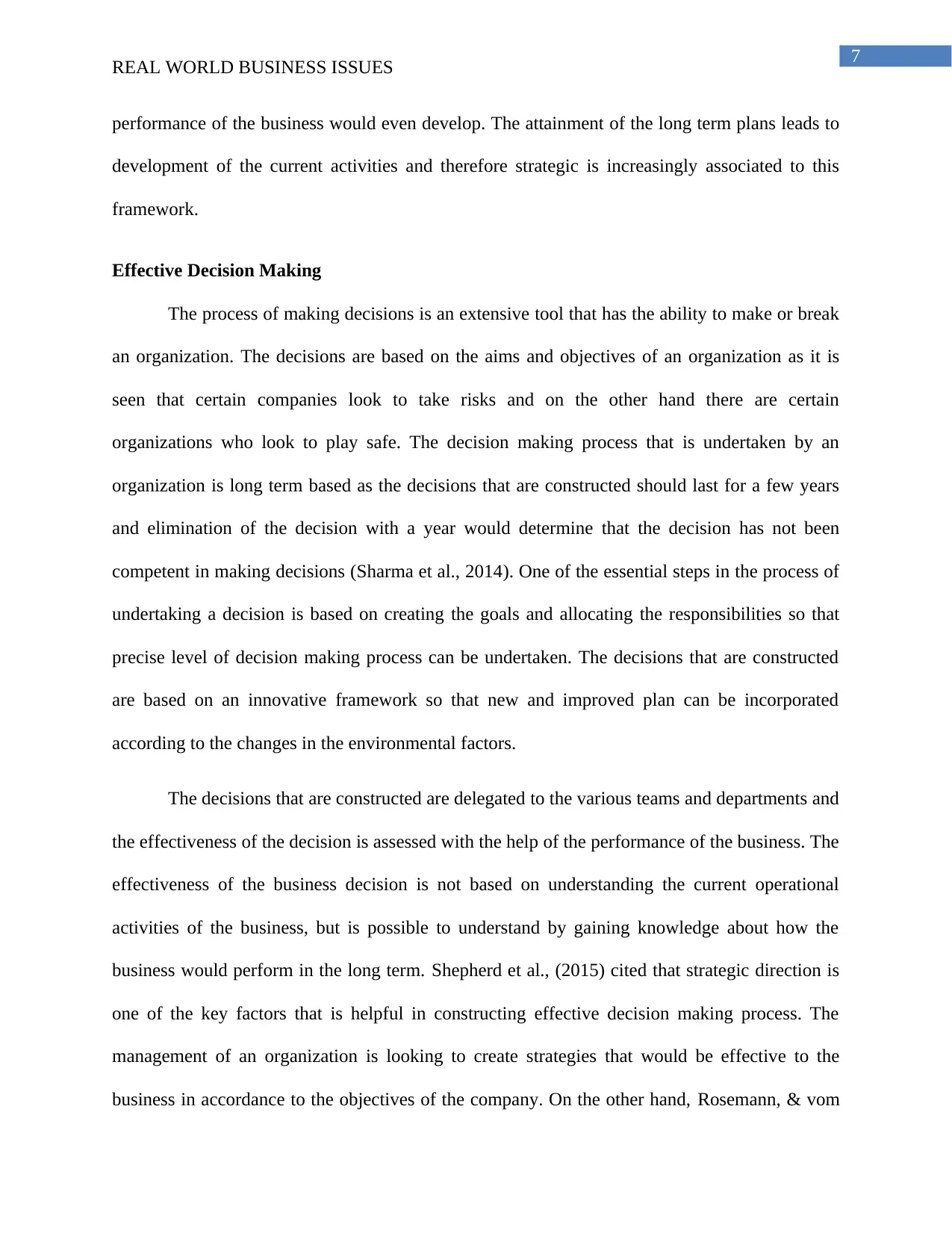
7
REAL WORLD BUSINESS ISSUES
performance of the business would even develop. The attainment of the long term plans leads to
development of the current activities and therefore strategic is increasingly associated to this
framework.
Effective Decision Making
The process of making decisions is an extensive tool that has the ability to make or break
an organization. The decisions are based on the aims and objectives of an organization as it is
seen that certain companies look to take risks and on the other hand there are certain
organizations who look to play safe. The decision making process that is undertaken by an
organization is long term based as the decisions that are constructed should last for a few years
and elimination of the decision with a year would determine that the decision has not been
competent in making decisions (Sharma et al., 2014). One of the essential steps in the process of
undertaking a decision is based on creating the goals and allocating the responsibilities so that
precise level of decision making process can be undertaken. The decisions that are constructed
are based on an innovative framework so that new and improved plan can be incorporated
according to the changes in the environmental factors.
The decisions that are constructed are delegated to the various teams and departments and
the effectiveness of the decision is assessed with the help of the performance of the business. The
effectiveness of the business decision is not based on understanding the current operational
activities of the business, but is possible to understand by gaining knowledge about how the
business would perform in the long term. Shepherd et al., (2015) cited that strategic direction is
one of the key factors that is helpful in constructing effective decision making process. The
management of an organization is looking to create strategies that would be effective to the
business in accordance to the objectives of the company. On the other hand, Rosemann, & vom
REAL WORLD BUSINESS ISSUES
performance of the business would even develop. The attainment of the long term plans leads to
development of the current activities and therefore strategic is increasingly associated to this
framework.
Effective Decision Making
The process of making decisions is an extensive tool that has the ability to make or break
an organization. The decisions are based on the aims and objectives of an organization as it is
seen that certain companies look to take risks and on the other hand there are certain
organizations who look to play safe. The decision making process that is undertaken by an
organization is long term based as the decisions that are constructed should last for a few years
and elimination of the decision with a year would determine that the decision has not been
competent in making decisions (Sharma et al., 2014). One of the essential steps in the process of
undertaking a decision is based on creating the goals and allocating the responsibilities so that
precise level of decision making process can be undertaken. The decisions that are constructed
are based on an innovative framework so that new and improved plan can be incorporated
according to the changes in the environmental factors.
The decisions that are constructed are delegated to the various teams and departments and
the effectiveness of the decision is assessed with the help of the performance of the business. The
effectiveness of the business decision is not based on understanding the current operational
activities of the business, but is possible to understand by gaining knowledge about how the
business would perform in the long term. Shepherd et al., (2015) cited that strategic direction is
one of the key factors that is helpful in constructing effective decision making process. The
management of an organization is looking to create strategies that would be effective to the
business in accordance to the objectives of the company. On the other hand, Rosemann, & vom
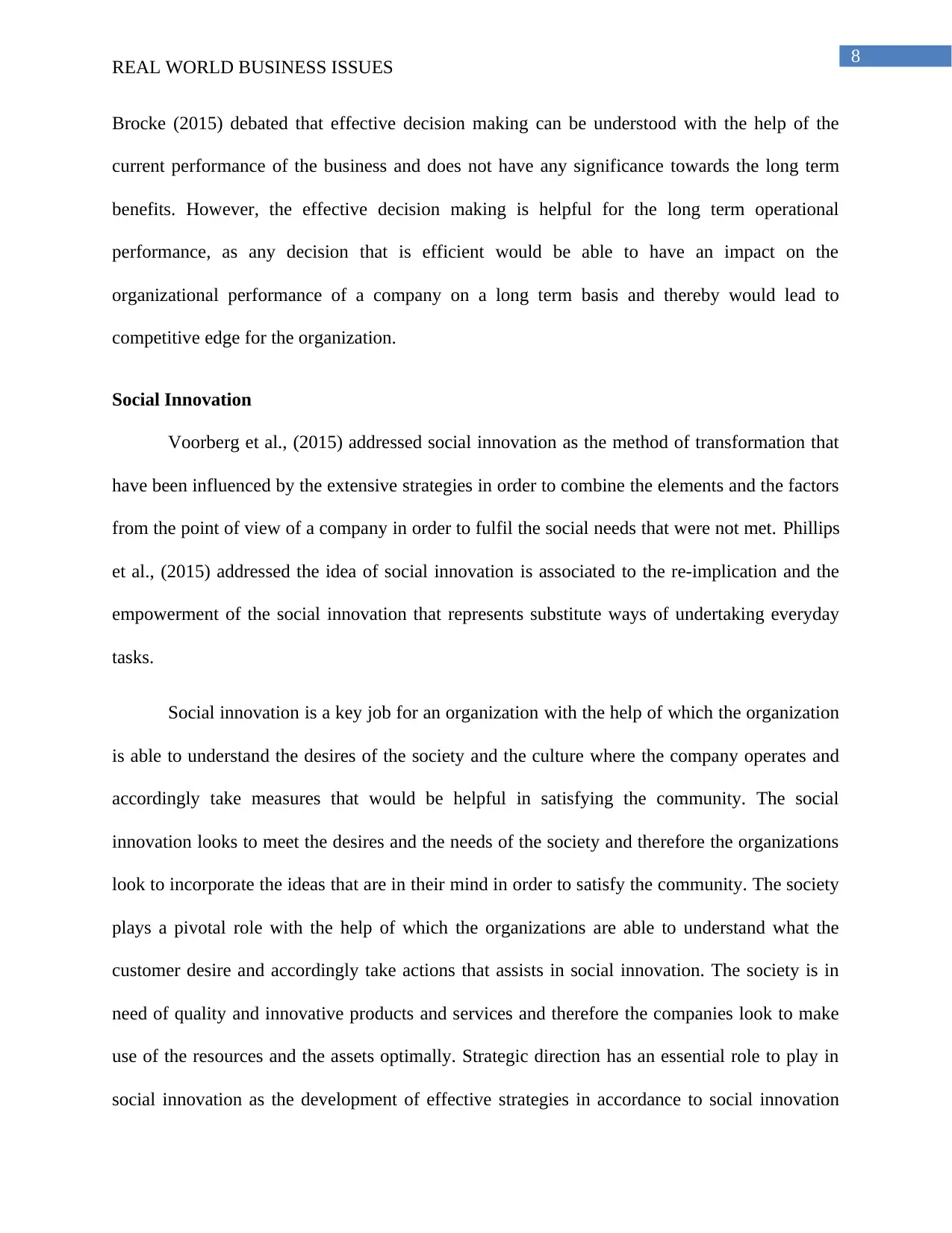
8
REAL WORLD BUSINESS ISSUES
Brocke (2015) debated that effective decision making can be understood with the help of the
current performance of the business and does not have any significance towards the long term
benefits. However, the effective decision making is helpful for the long term operational
performance, as any decision that is efficient would be able to have an impact on the
organizational performance of a company on a long term basis and thereby would lead to
competitive edge for the organization.
Social Innovation
Voorberg et al., (2015) addressed social innovation as the method of transformation that
have been influenced by the extensive strategies in order to combine the elements and the factors
from the point of view of a company in order to fulfil the social needs that were not met. Phillips
et al., (2015) addressed the idea of social innovation is associated to the re-implication and the
empowerment of the social innovation that represents substitute ways of undertaking everyday
tasks.
Social innovation is a key job for an organization with the help of which the organization
is able to understand the desires of the society and the culture where the company operates and
accordingly take measures that would be helpful in satisfying the community. The social
innovation looks to meet the desires and the needs of the society and therefore the organizations
look to incorporate the ideas that are in their mind in order to satisfy the community. The society
plays a pivotal role with the help of which the organizations are able to understand what the
customer desire and accordingly take actions that assists in social innovation. The society is in
need of quality and innovative products and services and therefore the companies look to make
use of the resources and the assets optimally. Strategic direction has an essential role to play in
social innovation as the development of effective strategies in accordance to social innovation
REAL WORLD BUSINESS ISSUES
Brocke (2015) debated that effective decision making can be understood with the help of the
current performance of the business and does not have any significance towards the long term
benefits. However, the effective decision making is helpful for the long term operational
performance, as any decision that is efficient would be able to have an impact on the
organizational performance of a company on a long term basis and thereby would lead to
competitive edge for the organization.
Social Innovation
Voorberg et al., (2015) addressed social innovation as the method of transformation that
have been influenced by the extensive strategies in order to combine the elements and the factors
from the point of view of a company in order to fulfil the social needs that were not met. Phillips
et al., (2015) addressed the idea of social innovation is associated to the re-implication and the
empowerment of the social innovation that represents substitute ways of undertaking everyday
tasks.
Social innovation is a key job for an organization with the help of which the organization
is able to understand the desires of the society and the culture where the company operates and
accordingly take measures that would be helpful in satisfying the community. The social
innovation looks to meet the desires and the needs of the society and therefore the organizations
look to incorporate the ideas that are in their mind in order to satisfy the community. The society
plays a pivotal role with the help of which the organizations are able to understand what the
customer desire and accordingly take actions that assists in social innovation. The society is in
need of quality and innovative products and services and therefore the companies look to make
use of the resources and the assets optimally. Strategic direction has an essential role to play in
social innovation as the development of effective strategies in accordance to social innovation
⊘ This is a preview!⊘
Do you want full access?
Subscribe today to unlock all pages.

Trusted by 1+ million students worldwide

9
REAL WORLD BUSINESS ISSUES
can lead to a better operational activities and sales for an organization. Van der Have, &
Rubalcaba (2016) on the other hand, states that strategic direction does not assist in social
innovation as strategic direction is associated to the functional activities of the organization and
is not concerned with any other activities. However, Epstein et al., (2015) addressed that
developing the capacity of the society to react and the satisfying their desires are the best way to
improve the functional activities of the business. Strategic innovation therefore looks to explore
the alternative processes and activities that would be helpful in social innovation and in a manner
improve the operational activities as well.
REAL WORLD BUSINESS ISSUES
can lead to a better operational activities and sales for an organization. Van der Have, &
Rubalcaba (2016) on the other hand, states that strategic direction does not assist in social
innovation as strategic direction is associated to the functional activities of the organization and
is not concerned with any other activities. However, Epstein et al., (2015) addressed that
developing the capacity of the society to react and the satisfying their desires are the best way to
improve the functional activities of the business. Strategic innovation therefore looks to explore
the alternative processes and activities that would be helpful in social innovation and in a manner
improve the operational activities as well.
Paraphrase This Document
Need a fresh take? Get an instant paraphrase of this document with our AI Paraphraser
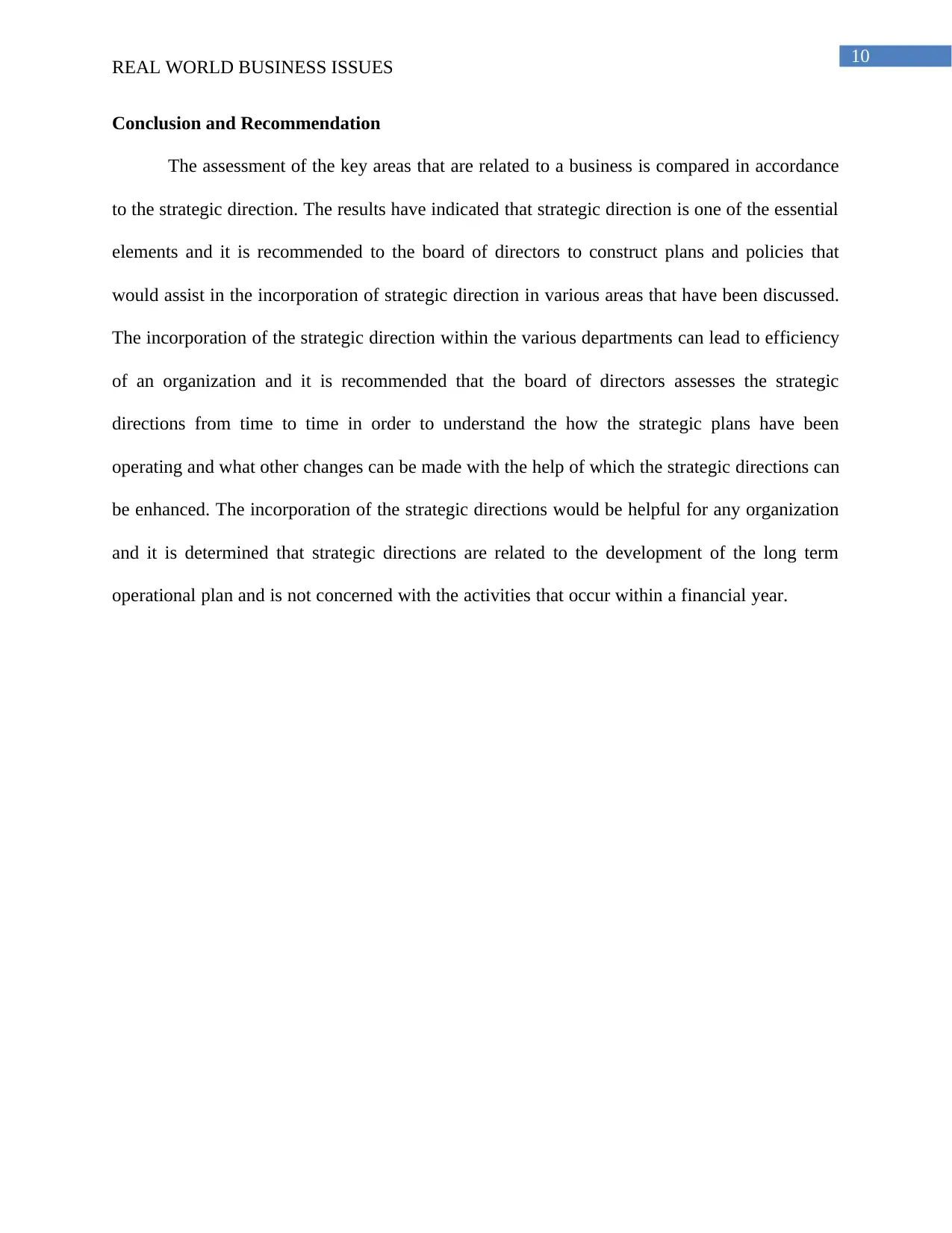
10
REAL WORLD BUSINESS ISSUES
Conclusion and Recommendation
The assessment of the key areas that are related to a business is compared in accordance
to the strategic direction. The results have indicated that strategic direction is one of the essential
elements and it is recommended to the board of directors to construct plans and policies that
would assist in the incorporation of strategic direction in various areas that have been discussed.
The incorporation of the strategic direction within the various departments can lead to efficiency
of an organization and it is recommended that the board of directors assesses the strategic
directions from time to time in order to understand the how the strategic plans have been
operating and what other changes can be made with the help of which the strategic directions can
be enhanced. The incorporation of the strategic directions would be helpful for any organization
and it is determined that strategic directions are related to the development of the long term
operational plan and is not concerned with the activities that occur within a financial year.
REAL WORLD BUSINESS ISSUES
Conclusion and Recommendation
The assessment of the key areas that are related to a business is compared in accordance
to the strategic direction. The results have indicated that strategic direction is one of the essential
elements and it is recommended to the board of directors to construct plans and policies that
would assist in the incorporation of strategic direction in various areas that have been discussed.
The incorporation of the strategic direction within the various departments can lead to efficiency
of an organization and it is recommended that the board of directors assesses the strategic
directions from time to time in order to understand the how the strategic plans have been
operating and what other changes can be made with the help of which the strategic directions can
be enhanced. The incorporation of the strategic directions would be helpful for any organization
and it is determined that strategic directions are related to the development of the long term
operational plan and is not concerned with the activities that occur within a financial year.

11
REAL WORLD BUSINESS ISSUES
Reference List
Aguinis, H., Edwards, J. R., & Bradley, K. J. (2017). Improving our understanding of
moderation and mediation in strategic management research. Organizational Research
Methods, 20(4), 665-685.
Bergh, D. D., Aguinis, H., Heavey, C., Ketchen, D. J., Boyd, B. K., Su, P., ... & Joo, H. (2016).
Using meta‐analytic structural equation modeling to advance strategic management
research: Guidelines and an empirical illustration via the strategic leadership‐
performance relationship. Strategic Management Journal, 37(3), 477-497.
Epstein, M. J., Buhovac, A. R., & Yuthas, K. (2015). Managing social, environmental and
financial performance simultaneously. Long range planning, 48(1), 35-45.
Hartmann‐Boyce, J., Boylan, A. M., Jebb, S. A., Fletcher, B., & Aveyard, P. (2017). Cognitive
and behavioural strategies for self‐directed weight loss: systematic review of qualitative
studies. Obesity Reviews, 18(3), 335-349.
Looy, A. V., Backer, M. D., & Poels, G. (2014). A conceptual framework and classification of
capability areas for business process maturity. Enterprise Information Systems, 8(2), 188-
224.
Ormazabal, M., Rich, E., Sarriegi, J. M., & Viles, E. (2017). Environmental management
evolution framework: Maturity stages and causal loops. Organization &
Environment, 30(1), 27-50.
REAL WORLD BUSINESS ISSUES
Reference List
Aguinis, H., Edwards, J. R., & Bradley, K. J. (2017). Improving our understanding of
moderation and mediation in strategic management research. Organizational Research
Methods, 20(4), 665-685.
Bergh, D. D., Aguinis, H., Heavey, C., Ketchen, D. J., Boyd, B. K., Su, P., ... & Joo, H. (2016).
Using meta‐analytic structural equation modeling to advance strategic management
research: Guidelines and an empirical illustration via the strategic leadership‐
performance relationship. Strategic Management Journal, 37(3), 477-497.
Epstein, M. J., Buhovac, A. R., & Yuthas, K. (2015). Managing social, environmental and
financial performance simultaneously. Long range planning, 48(1), 35-45.
Hartmann‐Boyce, J., Boylan, A. M., Jebb, S. A., Fletcher, B., & Aveyard, P. (2017). Cognitive
and behavioural strategies for self‐directed weight loss: systematic review of qualitative
studies. Obesity Reviews, 18(3), 335-349.
Looy, A. V., Backer, M. D., & Poels, G. (2014). A conceptual framework and classification of
capability areas for business process maturity. Enterprise Information Systems, 8(2), 188-
224.
Ormazabal, M., Rich, E., Sarriegi, J. M., & Viles, E. (2017). Environmental management
evolution framework: Maturity stages and causal loops. Organization &
Environment, 30(1), 27-50.
⊘ This is a preview!⊘
Do you want full access?
Subscribe today to unlock all pages.

Trusted by 1+ million students worldwide
1 out of 14
Related Documents
Your All-in-One AI-Powered Toolkit for Academic Success.
+13062052269
info@desklib.com
Available 24*7 on WhatsApp / Email
![[object Object]](/_next/static/media/star-bottom.7253800d.svg)
Unlock your academic potential
Copyright © 2020–2026 A2Z Services. All Rights Reserved. Developed and managed by ZUCOL.


